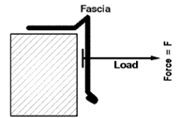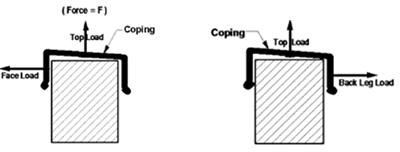SpecTopics: The ES-1 Standard and Metal Roof Edges
The topic of metal roof edges is one of high importance when it comes to the performance of a low-slope roof. In an extreme weather event with high winds, the edge of a low-slope roof is the likely failure of the system. Factory Mutual, a leading building insurance company, attributes 80% or more of all roof failures directly to failure of the roof edge.
The debate about shop-fabricated versus pre-manufactured roof edgings continued for years, until the adoption of the ANSI/SPRI ES-1 standard into the International Building Code (IBC). ES-1, the Wind Design Standard for Edge Systems Used with Low-Slope Roofing Systems, is comprised of three pull-off tests (two for fascia and one for coping) and is based on the American Society of Civil Engineers’ document ASCE-7 – Minimum Design Loads for Buildings and Other Structures.

Test Method RE-1 (Fascia) measures how well the edge secures the perimeter on ballasted and mechanically attached membranes.
- A static test with a 100 lb. load every foot.
- Membrane is pulled at a 45-degree angle to the roof deck to simulate a billowing membrane.
- Termination must withstand a minimum force of 100 lbs. per foot.
- Failure is defined as any event that allows the membrane to come free of the edge termination or allows the termination to come free.

Test Method RE-2 (Fascia) is a pull-off test for the metal edge flashing.
- Tests for wind load on the face dimension of the flashing system.
- Determines maximum load at failure.
- Failure is the loss of securement of any component of the roof edge system.

Test Method RE-3 (Coping) tests the strength of the metal coping cap to assure it meets or exceeds calculated design wind pressure.
- Tests wind load on both the top and back leg dimensions.
- Simultaneously tests the vertical and horizontal wind gust load coefficient.
- Failure is the loss of securement of any component of the roof edge system.
The main reason for the development of ES-1 was to improve the longevity and safety of low-slope commercial roofs and to protect the building owner’s investment by reducing the risk of edge failure – and consequentially roof failure. Basically, ES-1 provides formulas for calculating the wind load on edges of low-slope roofs and prescribes methodology for testing and evaluating the ability of edge systems to withstand those loads; as a result, this ensures wind resistance and long-term performance.
Specify ANSI/SPRI ES-1 compliant pre-manufactured roof edge or make sure your shop-fabricated roof edges are produced by an ANSI/SPRI ES-1 compliant shop.
For more information on ANSI/SPRI ES-1, go to the standards page on SPRI’s website here.
Contact Craig Tyler with questions.
The debate about shop-fabricated versus pre-manufactured roof edgings continued for years, until the adoption of the ANSI/SPRI ES-1 standard into the International Building Code (IBC). ES-1, the Wind Design Standard for Edge Systems Used with Low-Slope Roofing Systems, is comprised of three pull-off tests (two for fascia and one for coping) and is based on the American Society of Civil Engineers’ document ASCE-7 – Minimum Design Loads for Buildings and Other Structures.

Test Method RE-1 (Fascia) measures how well the edge secures the perimeter on ballasted and mechanically attached membranes.
- A static test with a 100 lb. load every foot.
- Membrane is pulled at a 45-degree angle to the roof deck to simulate a billowing membrane.
- Termination must withstand a minimum force of 100 lbs. per foot.
- Failure is defined as any event that allows the membrane to come free of the edge termination or allows the termination to come free.

Test Method RE-2 (Fascia) is a pull-off test for the metal edge flashing.
- Tests for wind load on the face dimension of the flashing system.
- Determines maximum load at failure.
- Failure is the loss of securement of any component of the roof edge system.

Test Method RE-3 (Coping) tests the strength of the metal coping cap to assure it meets or exceeds calculated design wind pressure.
- Tests wind load on both the top and back leg dimensions.
- Simultaneously tests the vertical and horizontal wind gust load coefficient.
- Failure is the loss of securement of any component of the roof edge system.
The main reason for the development of ES-1 was to improve the longevity and safety of low-slope commercial roofs and to protect the building owner’s investment by reducing the risk of edge failure – and consequentially roof failure. Basically, ES-1 provides formulas for calculating the wind load on edges of low-slope roofs and prescribes methodology for testing and evaluating the ability of edge systems to withstand those loads; as a result, this ensures wind resistance and long-term performance.
Specify ANSI/SPRI ES-1 compliant pre-manufactured roof edge or make sure your shop-fabricated roof edges are produced by an ANSI/SPRI ES-1 compliant shop.
For more information on ANSI/SPRI ES-1, go to the standards page on SPRI’s website here.
Contact Craig Tyler with questions.
Up Next
August 31, 2022
SpecTopics: Class A, B, and C - UL Fire Classifications for Roofs
UL tests the fire resistance of roof construction using External and Internal Fire Ratings. This SpecTopic will focus on the External Fire Ratings.
August 17, 2022
SpecTips: Enhanced Wind Warranties for Adhesiveless Systems
Carlisle's new 135-mil FleeceBACK RL PVC membrane is eligible for up to a 25-year system warranty, with wind speed coverage up to 120 mph peak gusts and 3” hail coverage.
July 27, 2022
SpecTips: A Permanent Hazard Warning for Your Roof
Building owners and their representatives, including architects and specifiers, must take steps to ensure safety for everyone that steps foot on the roof. This can be accomplished by specifying hazard warnings for the roof walkways and perimeters using permanent warning strips.

